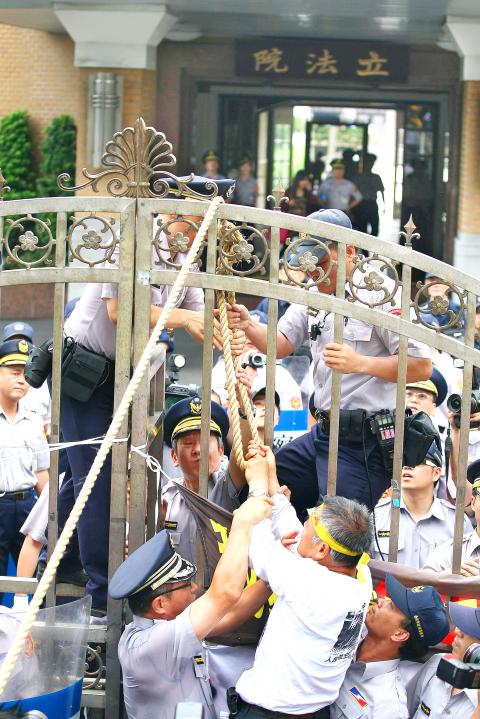Upset about a NT$14 billion (US$485.5 million) budget to continue construction of the Fourth Nuclear Power Plant in Gongliao District (貢寮), New Taipei City (新北市), that was passed by the legislature on Monday, anti--nuclear protesters yesterday rallied in front of the Legislative Yuan in Taipei to demand a referendum on the matter.
The rally organizer, the Taiwan Environmental Protection Union (TEPU), said the Fourth Nuclear Power Plant was a patchwork design assembled by Taiwan Power Co (Taipower), and could threaten the health of people living in Taiwan.
TEPU attempted to submit a petition to the legislature yesterday, asking for the decision to allow operation of the Fourth Nuclear Power Plant to be decided by public referendum, “but they won’t let us inside,” TEPU secretary-general Lee Cho-han (李卓翰) said.

Photo: CNA
“Protesting against nuclear power isn’t just about saving people in Taiwan, it’s also about saving the Earth,” Green Party Taiwan spokesperson Pan Han-shen (潘翰聲) said, adding that “people asked me why we don’t protest against the many nuclear power plants along China’s coastlines ... but we are not the same nation, so we can only control what’s happening in Taiwan and monitor our legislators.”
After protesters were blocked from submitting the petition or entering the Legislature Yuan by shield-wielding police, who lined up behind the closed gates, the protest organizer, a former TEPU chairman and professor at National Taiwan University, Kao Cheng-yan (高成炎), tried to climb the front gate of the legislature, causing a brief scuffle between protesters and police.
Kao said that the public paid for construction of the Legislative Yuan and lawmakers’ salaries, so they should be allowed to enter the legislature to submit their petitions instead of being shut out.

SHIPS, TRAINS AND AUTOMOBILES: The ministry has announced changes to varied transportation industries taking effect soon, with a number of effects for passengers Beginning next month, the post office is canceling signature upon delivery and written inquiry services for international registered small packets in accordance with the new policy of the Universal Postal Union, the Ministry of Transportation and Communications said yesterday. The new policy does not apply to packets that are to be delivered to China, the ministry said. Senders of international registered small packets would receive a NT$10 rebate on postage if the packets are sent from Jan. 1 to March 31, it added. The ministry said that three other policies are also scheduled to take effect next month. International cruise ship operators

HORROR STORIES: One victim recounted not realizing they had been stabbed and seeing people bleeding, while another recalled breaking down in tears after fleeing A man on Friday died after he tried to fight the knife-wielding suspect who went on a stabbing spree near two of Taipei’s busiest metro stations, Taipei Mayor Chiang Wan-an (蔣萬安) said. The 57-year-old man, identified by his family name, Yu (余), encountered the suspect at Exit M7 of Taipei Main Station and immediately tried to stop him, but was fatally wounded and later died, Chiang said, calling the incident “heartbreaking.” Yu’s family would receive at least NT$5 million (US$158,584) in compensation through the Taipei Rapid Transit Corp’s (TRTC) insurance coverage, he said after convening an emergency security response meeting yesterday morning. National

PLANNED: The suspect visited the crime scene before the killings, seeking information on how to access the roof, and had extensively researched a 2014 stabbing incident The suspect in a stabbing attack that killed three people and injured 11 in Taipei on Friday had planned the assault and set fires at other locations earlier in the day, law enforcement officials said yesterday. National Police Agency (NPA) Director-General Chang Jung-hsin (張榮興) said the suspect, a 27-year-old man named Chang Wen (張文), began the attacks at 3:40pm, first setting off smoke bombs on a road, damaging cars and motorbikes. Earlier, Chang Wen set fire to a rental room where he was staying on Gongyuan Road in Zhongzheng District (中正), Chang Jung-hsin said. The suspect later threw smoke grenades near two exits

The Forestry and Nature Conservation Agency yesterday launched a gift box to market honey “certified by a Formosan black bear” in appreciation of a beekeeper’s amicable interaction with a honey-thieving bear. Beekeeper Chih Ming-chen (池明鎮) in January inspected his bee farm in Hualien County’s Jhuosi Township (卓溪) and found that more than 20 beehives had been destroyed and many hives were eaten, with bear droppings and paw prints near the destroyed hives, the agency said. Chih returned to the farm to move the remaining beehives away that evening when he encountered a Formosan black bear only 20m away, the agency said. The bear